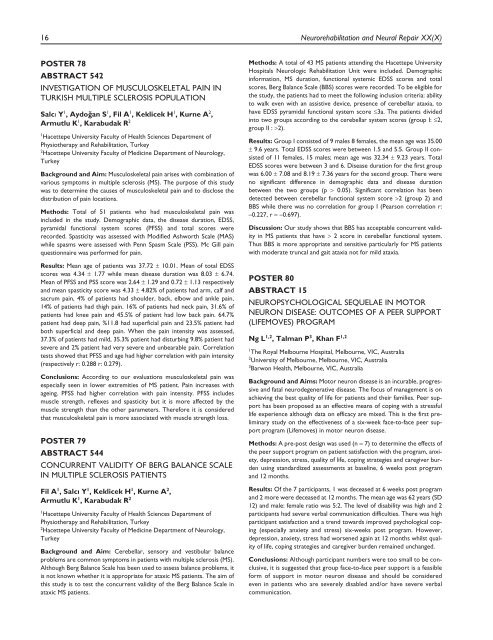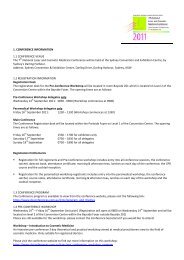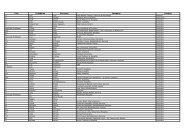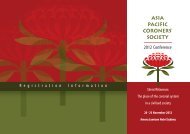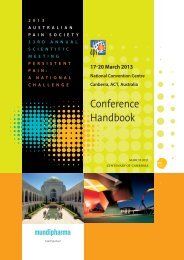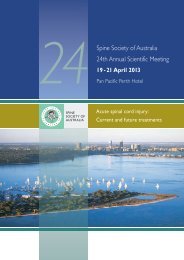WCNR 2012 Poster Abstracts - DC Conferences
WCNR 2012 Poster Abstracts - DC Conferences
WCNR 2012 Poster Abstracts - DC Conferences
Create successful ePaper yourself
Turn your PDF publications into a flip-book with our unique Google optimized e-Paper software.
16 Neurorehabilitation and Neural Repair XX(X)POSTER 78ABSTRACT 542INVESTIGATION OF MUSCULOSKELETAL PAIN INTURKISH MULTIPLE SCLEROSIS POPULATIONSalcı Y 1 , Aydoğan S 1 , Fil A 1 , Keklicek H 1 , Kurne A 2 ,Armutlu K 1 , Karabudak R 21 Hacettepe University Faculty of Health Sciences Department ofPhysiotherapy and Rehabilitation, Turkey2 Hacettepe University Faculty of Medicine Department of Neurology,TurkeyBackground and Aim: Musculoskeletal pain arises with combination ofvarious symptoms in multiple sclerosis (MS). The purpose of this studywas to determine the causes of musculoskeletal pain and to disclose thedistribution of pain locations.Methods: Total of 51 patients who had musculoskeletal pain wasincluded in the study. Demographic data, the disease duration, EDSS,pyramidal functional system scores (PFSS) and total scores wererecorded. Spasticity was assessed with Modified Ashworth Scale (MAS)while spasms were assessed with Penn Spasm Scale (PSS). Mc Gill painquestionnaire was performed for pain.Results: Mean age of patients was 37.72 10.01. Mean of total EDSSscores was 4.34 1.77 while mean disease duration was 8.03 6.74.Mean of PFSS and PSS score was 2.64 1.29 and 0.72 1.13 respectivelyand mean spasticity score was 4.33 4.82% of patients had arm, calf andsacrum pain, 4% of patients had shoulder, back, elbow and ankle pain,14% of patients had thigh pain. 16% of patients had neck pain, 31.6% ofpatients had knee pain and 45.5% of patient had low back pain. 64.7%patient had deep pain, %11.8 had superficial pain and 23.5% patient hadboth superficial and deep pain. When the pain intensity was assessed,37.3% of patients had mild, 35.3% patient had disturbing 9.8% patient hadsevere and 2% patient had very severe and unbearable pain. Correlationtests showed that PFSS and age had higher correlation with pain intensity(respectively r: 0.288 r: 0.279).Conclusions: According to our evaluations musculoskeletal pain wasespecially seen in lower extremities of MS patient. Pain increases withageing. PFSS had higher correlation with pain intensity. PFSS includesmuscle strength, reflexes and spasticity but it is more affected by themuscle strength than the other parameters. Therefore it is consideredthat musculoskeletal pain is more associated with muscle strength loss.POSTER 79ABSTRACT 544CONCURRENT VALIDITY OF BERG BALANCE SCALEIN MULTIPLE SCLEROSIS PATIENTSFil A 1 , Salcı Y 1 , Keklicek H 1 , Kurne A 2 ,Armutlu K 1 , Karabudak R 21 Hacettepe University Faculty of Health Sciences Department ofPhysiotherapy and Rehabilitation, Turkey2 Hacettepe University Faculty of Medicine Department of Neurology,TurkeyBackground and Aim: Cerebellar, sensory and vestibular balanceproblems are common symptoms in patients with multiple sclerosis (MS).Although Berg Balance Scale has been used to assess balance problems, itis not known whether it is appropriate for ataxic MS patients. The aim ofthis study is to test the concurrent validity of the Berg Balance Scale inataxic MS patients.Methods: A total of 43 MS patients attending the Hacettepe UniversityHospitals Neurologic Rehabilitation Unit were included. Demographicinformation, MS duration, functional systemic EDSS scores and totalscores, Berg Balance Scale (BBS) scores were recorded. To be eligible forthe study, the patients had to meet the following inclusion criteria: abilityto walk even with an assistive device, presence of cerebellar ataxia, tohave EDSS pyramidal functional system score 3a. The patients dividedinto two groups according to the cerebellar system scores (group I: 2,group II : 2).Results: Group I consisted of 9 males 8 females, the mean age was 35.00 9.6 years. Total EDSS scores were between 1.5 and 5.5. Group II consistedof 11 females, 15 males; mean age was 32.34 9.23 years. TotalEDSS scores were between 3 and 6. Disease duration for the first groupwas 6.00 7.08 and 8.19 7.36 years for the second group. There wereno significant difference in demographic data and disease durationbetween the two groups (p 0.05). Significant correlation has beendetected between cerebellar functional system score 2 (group 2) andBBS while there was no correlation for group I (Pearson correlation r:–0.227, r –0.697).Discussion: Our study shows that BBS has acceptable concurrent validityin MS patients that have 2 score in cerebellar functional system.Thus BBS is more appropriate and sensitive particularly for MS patientswith moderate truncal and gait ataxia not for mild ataxia.POSTER 80ABSTRACT 15NEUROPSYCHOLOGICAL SEQUELAE IN MOTORNEURON DISEASE: OUTCOMES OF A PEER SUPPORT(LIFEMOVES) PROGRAMNg L 1,2 , Talman P 3 , Khan F 1,21 The Royal Melbourne Hospital, Melbourne, VIC, Australia2 University of Melbourne, Melbourne, VIC, Australia3 Barwon Health, Melbourne, VIC, AustraliaBackground and Aims: Motor neuron disease is an incurable, progressiveand fatal neurodegenerative disease. The focus of management is onachieving the best quality of life for patients and their families. Peer supporthas been proposed as an effective means of coping with a stressfullife experience although data on efficacy are mixed. This is the first preliminarystudy on the effectiveness of a six-week face-to-face peer supportprogram (Lifemoves) in motor neuron disease.Methods: A pre-post design was used (n 7) to determine the effects ofthe peer support program on patient satisfaction with the program, anxiety,depression, stress, quality of life, coping strategies and caregiver burdenusing standardized assessments at baseline, 6 weeks post programand 12 months.Results: Of the 7 participants, 1 was deceased at 6 weeks post programand 2 more were deceased at 12 months. The mean age was 62 years (SD12) and male: female ratio was 5:2. The level of disability was high and 2participants had severe verbal communication difficulties. There was highparticipant satisfaction and a trend towards improved psychological coping(especially anxiety and stress) six-weeks post program. However,depression, anxiety, stress had worsened again at 12 months whilst qualityof life, coping strategies and caregiver burden remained unchanged.Conclusions: Although participant numbers were too small to be conclusive,it is suggested that group face-to-face peer support is a feasibleform of support in motor neuron disease and should be consideredeven in patients who are severely disabled and/or have severe verbalcommunication.


